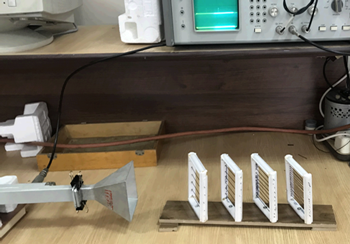Optimization of radiation characteristics of linear focusing array consisting of semitransparent mirrors
DOI:
https://doi.org/10.3103/S0735272723090030Keywords:
linear focusing array, quasi-optical conditions, reflection and transmission coefficients, radiation pattern, RP, variational statement, frequency radiation in GHz rangeAbstract
The paper is devoted to the optimization of the radiation characteristics of a linear focusing array, which consists of a set of semitransparent inclined elements (mirrors), an excitation source, and an end opaque mirror. The array geometry satisfies the quasi-optical conditions, while the inclination of mirrors is set in such a way that the array allows us to focus the scattered field in the Frenzel zone and the far zone. The formation of a radiation pattern (RP) close to the specified one, or the provision of maximum radiation in the given region of angular coordinates is achieved by choosing the reflection and transmission coefficients of semitransparent elements of the array. To ensure these requirements, a variational statement of the optimization problem is used. The maximization of corresponding functionals is achieved numerically by the methods of successive approximations. Numerical experiments demonstrate high accuracy in fulfilling the requirements of the radiation characteristics which is also confirmed by experimental data.
References
- N. N. Voitovich, V. V. Semyonov, “On the forming the fields of the prescribed structure,” Radiotech. Electron., vol. 13, no. 7, pp. 1213–1221, 1968.
- N. N. Voitovich, V. V. Semyonov, “Quasioptical lines – fiders,” Radiotech. Electron., vol. 156, no. 4, pp. 697–704, 1970.
- O. O. Bulatsyk, N. N. Voitovich, B. Z. Katsenelenbaum, Y. P. Topoliuk, Phase optimization problems. Application in wave field theory, [in Ukrainian]. Kyiv: Naukova Dumka, 2012.
- K. Klem-Musatov, H. C. Hoeber, T. J. Moser, M. A. Pelissier, Classical and Modern Diffraction Theory. Society of Exploration Geophysicists, 2016.
- A. V. Osipov, S. A. Tretyakov, Modern Electromagnetic Scattering Theory with Applications. Wiley, 2017, doi: https://doi.org/10.1002/9781119004639.
- P. Y. Ufimtsev, Fundamentals of the Physical Theory of Diffraction. Wiley, 2014, doi: https://doi.org/10.1002/9781118753767.
- P. H. Pathak, G. Carluccio, M. Albani, “The uniform geometrical theory of diffraction and some of its applications,” IEEE Antennas Propag. Mag., vol. 55, no. 4, pp. 41–69, 2013, doi: https://doi.org/10.1109/MAP.2013.6645140.
- G. Apaydin, F. Hacivelioglu, L. Sevgi, W. B. Gordon, P. Y. Ufimtsev, “Diffraction at a rectangular plate: First-order PTD approximation,” IEEE Trans. Antennas Propag., vol. 64, no. 5, pp. 1891–1899, 2016, doi: https://doi.org/10.1109/TAP.2016.2536171.
- A. Becker, V. Hansen, “A hybrid method combining the multitemporal resolution time-domain method of moments with the time-domain geometrical theory of diffraction for thin-wire antenna problems,” IEEE Trans. Antennas Propag., vol. 54, no. 3, pp. 953–960, 2006, doi: https://doi.org/10.1109/TAP.2006.869906.
- N. N. Voitovich, Y. N. Kazantsev, V. P. Tkachuk, “Creating a given radiation pattern by quasioptical line,” Radiotech. Electron., vol. 29, no. 6, pp. 1023–1028, 1984.
- M. I. Andriychuk, V. P. Tkachuk, “Three-dimensional model of a focusing and radiating antenna array,” J. Math. Sci., vol. 277, no. 1, pp. 133–144, 2023, doi: https://doi.org/10.1007/s10958-023-06821-3.
- A. D. Shatrow, A. D. Chuprin, A. N. Sivov, “Constructing the phase converters consisting of arbitrary number of translucent surfaces,” IEEE Trans. Antennas Propag., vol. 43, no. 1, pp. 109–113, 1995, doi: https://doi.org/10.1109/8.366360.
- Y. Wang, X.-X. Yang, G.-N. Tan, S. Gao, “Study on millimeter-wave SIW rectenna and arrays with high conversion efficiency,” IEEE Trans. Antennas Propag., vol. 69, no. 9, pp. 5503–5511, 2021, doi: https://doi.org/10.1109/TAP.2021.3060120.
- N. N. Voitovich, M. I. Andriychuk, “Transformation of field in regular waveguide via phase correctors,” in 2007 XIIth International Seminar/Workshop on Direct and Inverse Problems of Electromagnetic and Acoustic Wave Theory, 2007, pp. 63–66, doi: https://doi.org/10.1109/DIPED.2007.4373575.
- M. I. Andriychuk, Antenna Synthesis through the Characteristics of Desired Amplitude. Newcastle, UK: Cambridge Scholars Publishing, 2019.
- M. Andriychuk, V. Tkachuk, “3D radiating and focusing antenna system,” in 2021 IEEE 26th International Seminar/Workshop on Direct and Inverse Problems of Electromagnetic and Acoustic Wave Theory (DIPED), 2021, pp. 23–27, doi: https://doi.org/10.1109/DIPED53165.2021.9552286.
- O. O. Bulatsyk, B. Z. Katsenelenbaum, Y. P. Topolyuk, N. N. Voitovich, Phase Optimization Problems. Wiley, 2010, doi: https://doi.org/10.1002/9783527629824.
- R. L. Haupt, “Antenna arrays in the time domain: An introduction to timed arrays,” IEEE Antennas Propag. Mag., vol. 59, no. 3, pp. 33–41, 2017, doi: https://doi.org/10.1109/MAP.2017.2686082.
- Y. I. Nefedov, A. N. Sivov, Electrodynamics of Periodical Structures, [in Russian]. Moscow: Nauka, 1977.
- R. A. Valitov, S. F. Dyubko, V. V. Kamyshan, Techniques of Submillimeter Waves. Moscow: Sov. Radio, 1969.
- H. Li, X. He, X. Chen, Y. Fang, Q. Fang, “Wi-motion: A robust human activity recognition using WiFi signals,” IEEE Access, vol. 7, pp. 153287–153299, 2019, doi: https://doi.org/10.1109/ACCESS.2019.2948102.


